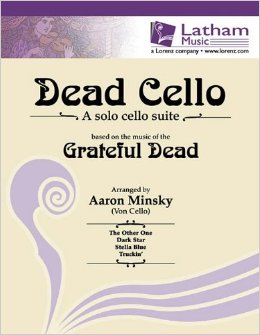Dead Classical Lives!

To many people the words “Dead” and “Classical” are opposites, but in reality, they are quite related. It was a Brahms symphony that inspired Phil Lesh to become a musician. He played violin and trumpet before switching to bass. And it was at a college course taught by modern classical composer, Luciano Berio, where he met Tom Constanten. Most people don’t know that experiments by modern classical composers in the mid 20th century set the stage for the multi-media presentations of the Acid Tests. You can hear the modern classical influence in the percussive transition on Anthem of the Sun. There is classical influence in the orchestral arrangements on “Terrapin.” And, of course, modern classical informs many of the band’s freeform jams. Yet few Deadheads know how to play classical music and few classical musicians know how to play Dead.
I was a rock guitar player when I first got turned on to the Dead. In June of 1973 a couple of guys from my high school chartered a bus and we took a “class trip” to RFK Stadium to attend what became known as one of the all-time great Dead shows. After that concert I was hooked and proceeded to learn every tune the band played… and many of Jerry’s solos. My method was to jam along with the records and a growing collection of bootleg tapes. I also performed the songs and had long jam sessions with friends.
Though I dreamed of joining the band I realized the Dead already had two guitarists and didn’t need a third. But I was also playing the cello at school and one day brought it home and started playing along. With the cello I found a new voice to complement the interplay between Jerry, Bob and Phil. I knew I could fit in with those guys but I realized I first had to become a professional cellist, so off I went to music school, eventually obtaining a Master of Music degree from Manhattan School of Music. Upon graduating I joined a symphony orchestra and later formed a trio that gave concerts and radio broadcasts.
Though I had become a bona fide classical cellist I yearned to go back to my rock roots – but how? Since there was no method book on rock cello, I decided to create my own. I called it “Ten American Cello Etudes” (published by Oxford University Press). About a dozen books followed. The pieces became so popular they are now considered “standard repertoire.” Once I perfected my new rock cello style, I formed a band: Von Cello (a nickname from my high school days). My band started cutting CDs and touring. I became a Yamaha Artist and a D’Addario Artist. I made TV and radio appearances and performed with famous artists including David Bowie. I got accepted into Who’s Who in America and the International Who’s Who. But I still couldn’t figure out how to play with the Dead.
I decided to attend lectures given by Mickey Hart and Phil Lesh. At the lectures I gave Von Cello CD’s to each. I also hired a lawyer to send my CD’s to other members of the Dead’s entourage. By now the Dead knew who I was but still… no phone call! So I figured it was time to start recording Dead music myself. I placed a cover of “The Other One” on the Von Cello CD, Excalibur. Scott Guberman, a member of the Vince Welnick Band (and keyboardist with Tom Constanten) heard the CD and contacted me and soon we were recording the next Von Cello CD: Celtar (including a 14 minute cover of “Bird Song”). We also made a nice video of “Althea.”
The album cuts were picked up by David Gans and played on his radio show, “The Grateful Dead Hour”. I was also interviewed and played my Dead covers on Don Grossinger’s, “Morning Dew” on WBAI, and the “Joey Reynolds Show” on WOR.
Having recorded Dead covers, it was time to take the next step – I composed an arrangement of Dead tunes for solo cello. I called it: “Dead Cello” (published by Latham music). Soon other classical arrangements were published such as Dead Symphony No. 6, followed by concerts with symphony orchestra given by Warren Haynes and Bob Weir. Alan Trist, president of Ice Nine (the Dead’s publisher) told me, “There is more to come in this field and you have paved the way”. Since then I have performed “Dead Cello” in New York, London, Dublin and Tasmania, among other places. And now, this summer, at Georgia State University, I’ll be teaching a course for classical musicians on how to play Dead. It won’t be long until mixing classical and Dead music together will seem perfectly natural. Who knows what incredible new music may result?
With the Dead playing its final shows, it seems I may never live my dream of “playing in the band” but I can take enormous pride in the fact that I helped open the door between the Dead and the classical world. Thanks to my arrangements there are cellists around the world breathing new life into Dead Cello! (I recently heard of performances in Colorado, Alaska, China and Viet Nam.) I sincerely appreciate this opportunity to recount my small but unique contribution to the ever-evolving, always amazing, history of the Grateful Dead.
_____
For more on Aaron Minsky (Von Cello) check out: http://www.voncello.com and http://www.youtube.com/voncello



















